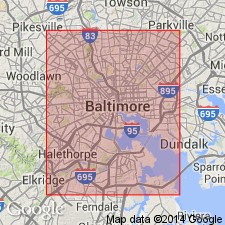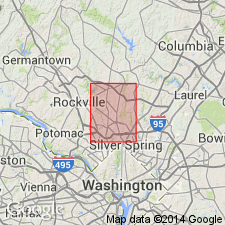
- Usage in publication:
-
- Woodstock granite*
- Modifications:
-
- Original reference
- Dominant lithology:
-
- Granite
- AAPG geologic province:
-
- Piedmont-Blue Ridge province
Summary:
(USGS map of Baltimore and vicinity, to accompany "Guide to Baltimore," prepared for Baltimore meeting Amer. Inst. Mining Engineers Feb. 1892). Woodstock granite. Includes eruptive granite and gneiss. Quarried at Woodstock and others places. Age is Carboniferous(?).
Named from Woodstock, Howard Co., northern MD.
Source: US geologic names lexicon (USGS Bull. 896, p. 2369); supplemental information from GNU records (USGS DDS-6; Reston GNULEX).

- Usage in publication:
-
- Woodstock Granite*
- Modifications:
-
- Age modified
- Geochronologic dating
- AAPG geologic province:
-
- Piedmont-Blue Ridge province
Summary:
The Woodstock Granite appears on the generalized geologic map of the MD Piedmont (figure 1) as Ordovician in age. Isotopic age of 444 Ma is credited to A.K. Sinha (written communication). The Woodstock is considered to be comagmatic with the Guilford Granite which occurs in the Kensington quad.
Source: GNU records (USGS DDS-6; Reston GNULEX).
For more information, please contact Nancy Stamm, Geologic Names Committee Secretary.
Asterisk (*) indicates published by U.S. Geological Survey authors.
"No current usage" (†) implies that a name has been abandoned or has fallen into disuse. Former usage and, if known, replacement name given in parentheses ( ).
Slash (/) indicates name conflicts with nomenclatural guidelines (CSN, 1933; ACSN, 1961, 1970; NACSN, 1983, 2005, 2021). May be explained within brackets ([ ]).

